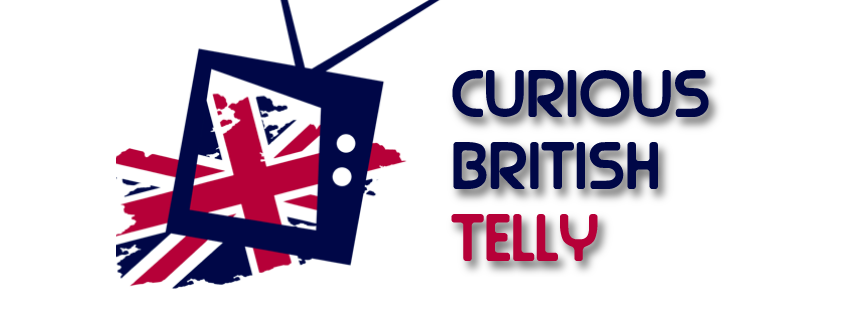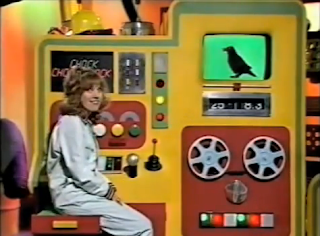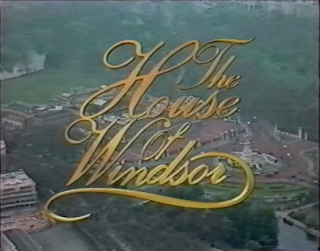Channel: BBC1
Transmission: 21/05/1981 - 13/08/1981
Computers were a source of complete and utter wonder to us as young children. They promised great, exciting things such as blocky graphics, bleeping soundcards and BASIC programming.
It doesn't sound much now, but it was a real escape from the tedium of life in the mid 80s. Our early memories of computers involve being in Dixons and setting off alarms as we flapped out tiny hands at the machines.
A much less frantic time with computers was spent lazing out on the sofa watching Chock-a-Block.
The series concerns itself with the less than sentient supercomputer, Chock-a-Block. Operating the machine are Chockabloke (Fred Harris) and Chockagirl (Carol Leader).
Each episode sees one of these Chockafolk arriving by way of their electric Chockatruck. Greeting the audience, they grab a 'block' which they awkwardly force into Chock-a-Block.
A small screen whirrs into life and displays a series of computer generated pictures - we're talking 8-bit not Pixar - which the Chockaperson has to identify. If they guess correctly, then a positive chime sounds! Guess incorrectly and they receive a rather flatulent response!
A rhyming theme runs through all the pictures e.g. crow, snow, toe and this leads to a song involving one of the pictures. The chockaperson then moves over to the Rockablock where they try and match up two pictures with similar rhyming sounds.
Finally, the chockaperson announces it's time for a song which results in a short animation commencing. Job done, the Chockaperson bids goodbye and jumps on their Chockatruck to, no doubt, get down the Chockapub.
Chock-a-Block was a thirteen part series which first aired in 1981 as part of the newly titled See-Saw slot on BBC1.
The series was created by children's TV supremo, Michael Cole who was also behind Fingerbobs, Bod, Pigeon Street, Bric-a-Brac and Gran. Writing the series alongside Cole was Nick Wilson who also directed the show. The marvelously modulated theme tune which SOUNDED LIKE A COMPUTER WAS TALKING!!! was composed by Peter Gosling.
Chock-a-Block was repeated fairly regularly up until 1989 where, we suspect, it began to look rather dated.
Chock-a-Block, unfortunately, seems to have been a late victim of BBC junking. Episodes were still being shown in 1989, so the wiping of these videotapes is distressingly late.
Kaleidoscope list 8 missing episode in their Lost Shows database, so that's over HALF the series. Out of the missing shows, a number of these have surfaced on YouTube and various torrent sites.
A poster on the Missing Episodes forum has noted that although the BBC have 'lost' the original 1" videotapes for a number of episodes, they do hold off air copies of all episodes[1]. This leaves us with a slim chance of there being a DVD remastered boxset one day complete with free block toy. Or perhaps not...
Curious British Telly's favourite part of the show is the electronictastic theme tune. It's a chirpy explosion of electronic drums, synths and 'computerised' speech which promises the future.
Most children of the early 80s probably weren't aware of the building synthpop movement, so Chock-a-Block no doubt acted as their introduction to electronic music.
Carol Leader and Fred Harris are both cheery, likable presenters forged in the primordial soup of children's television. Their roles in Chock-a-Block aren't complex, so all they're required to portray is a beaming smile and a slightly curious nature. Not testing, then, but they both give warm performances.
Mary Penley-Edwards has done a great job of designing Chockablock. It's a great, big colourful machine covered in flashing lights and movements. The reel-to-reel based face helps gives the machine a smidgeon of humanity and something to relate to. Perfect for arresting a child's errant attention. Kids today, of course, would scoff at its lack of HDMI sockets, but back in the 80s it felt like a thing of wonder.
The rhyming theme gives the show an educational feel and the picture sections allow the kiddywinks at home to interact. The pictures are ridiculously easy to guess and we found ourselves shouting "IT'S A HAT FOR CHRIST'S SAKE!" at the screen. We doubt even kids would struggle with this.
The rapport between the presenter and Chock-a-Block is rather limited. This leaves the presenter rather isolated and having to keep up spirits with a stream of consciousness. If the machine had been given more of a personality then it would have been a snappier affair.
The rockablock section is interminably dull and fails to advance the rhyming theme. Being a manually controlled affair, rockablock seems rather out of place with the computerised leanings of the show. Seemingly, it's been bolted on to fill up the running time.
We were more keen on the songs and animated sections of Chock-a-Block. The songs are dreamy little pieces which seem to have drifted in from a different age. These fuzzy little bursts of nostalgia make children's tv such emotional affairs and send our amygdala into overdrive.
Disturbingly, though, one song features a puppet cat which appears to have a cleft lip. It's the thing of nightmares and we're having trouble erasing it from our memory. Hopefully, the little horror was burnt to a cinder so it could do no more harm. Its possible, though, that it rose, phoenix like, from the ashes to become Scragtag.
Rewatching Chock-a-Block brought back some nice memories for Curious British Telly. There's a good show bursting to get out, but it doesn't quite happen on this occasion. Despite having some nice interactivity and animated sections, the rest of the show feels static and it fails to fully charm. However, we would still watch other episodes if they become available and certainly don't think the show was worth junking.
INTERVIEW
Carol Leader was gracious enough to spare some time to answer a few questions about the show.
CBT: You started appearing on our screens during the late 70s, notably with Play School, but how exactly did you get into the acting game?
Carol: I had acted in drama groups since being a teenager
and continued when I went to University. After uni, I did a graduate one-year
course at Bretton College in teaching drama. There I helped to form and became
a founder member of a theatre company called Perspectives that became a
professional group where I finished the course. The company is still going
today under the name of New Perspectives. They are based in Nottinghamshire and
recently celebrated their 40 year birthday.
It’s been over 30 years since Chock-a-Block first aired, but
what can you recall about getting involved with the show?
I was doing Play School at the time and also doing a lot of
acting parts in theatre and for TV. The producer asked me if I would like to
take the female presenter part in a new series he was devising to get young
children interested in simple computers. (How times have changed!)
Do you have any particular memories from recording
Chock-a-Block that stand out?
Mostly crashing the car and having to go for re-takes. Also
working with the directors and learning to relate to Chock-A- Block as another
character.
Unfortunately, the BBC appear to have wiped a number of the
original videotapes for Chock-a-Block. Were you aware of this and what are your
feelings towards the loss?
It’s a great shame that this was all before the digital age.
Nowadays it would have been much easier to save things. Many important BBC
drama productions and programmes have ended in the same way. It’s a shame they
have not been archived.
You left the acting world to pursue a career in
psychotherapy, but what prompted this change? And how do the two professions
compare?
In some surface ways they are very different: one is very
visible and the other has very strict boundaries of privacy – but at the heart
of both is I feel an interest in the human psyche – what makes us all tick –
especially in drama. But also Play School and Chockablock were made with strong
developmental considerations that link in well with our understanding of what
children need to develop – and that drama, narrative and story telling are
strong features of this. Many actors –
as well as others- find themselves in therapy, as I did and then found my
interest moving to a more specific exploration of the inner world and how
having an inner emotional world that is very different from the external world
impacts on human beings in helpful and unhelpful ways.






























